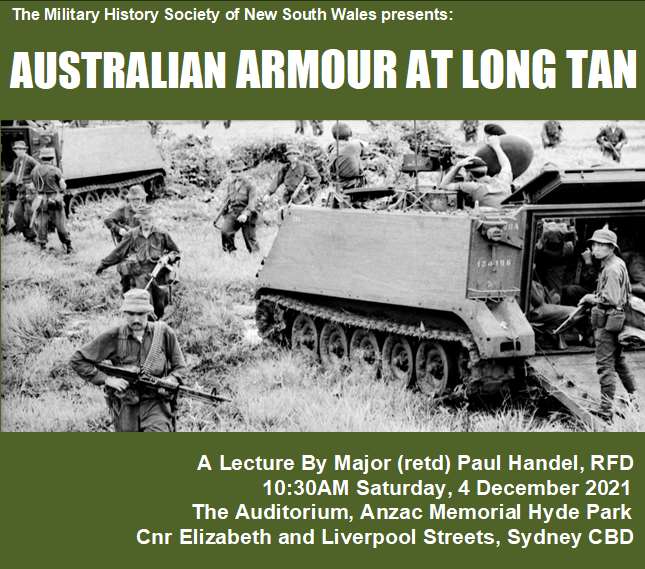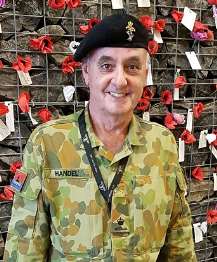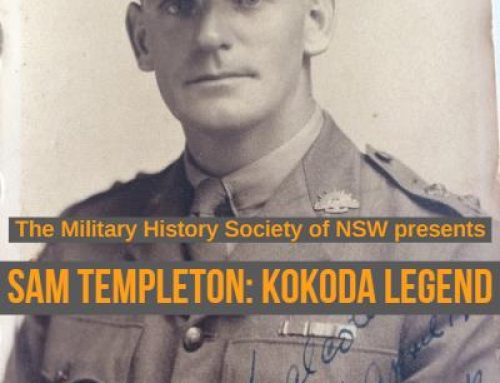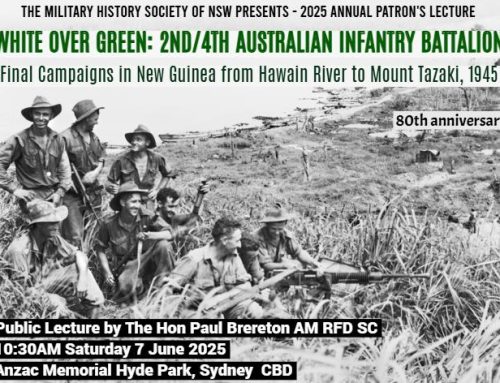A lecture by Major (retd) Paul Handel, RFD

On the afternoon of 18 August 1966, Delta Company of 6th Battalion, the Royal Australian Regiment (D/6RAR), fought a desperate battle with a force of North Vietnamese regular troops, a main force regiment of some 2,500 men about 1,000 of whom directly engaged the Australians. The battle became famous as the Battle of Long Tan. 18th August is now commemorated by all Vietnam Veterans as their day. The story of this epic battle has been told elsewhere, but this presentation looks at the role and actions of the Australian armoured unit.
That unit was 3 Troop, 1st Armoured Personnel Carrier Squadron (1 APC Sqn). They were equipped with the M113A1 Armoured Personnel Carrier (APC), a light tracked, aluminium-hulled, armoured vehicle which had been introduced into Australian service in 1964. The unit had been deployed to South Vietnam in 1965.
No 3 Troop, commanded by Lieutenant Adrian Roberts, was given the task of lifting an infantry company to reinforce Delta Company. He had ten M113A1 in his Troop. A large proportion of the soldiers of 3 Troop were National Servicemen, and their actions brought great credit to them.
The Troop was dispatched, with Alpha Company 6 RAR (A/6RAR) aboard, to the battle area late in the afternoon. They joined the battle. Heavy 0.50 inch Machine Guns on the APCs inflicted many casualties on the enemy.
The presentation will give an overview of the M113A1 Armoured Personnel Carrier as used by 1 APC Sqn including its capabilities. The movement of the Troop to the Long Tan plantation and its subsequent engagement with enemy forces will be covered, as will events after reaching D Company.
There is no doubt that the shock action and firepower the APCs contributed greatly to the successful reinforcement of D Company, and thus established the need for armour in jungle conditions, a need that was forgotten after the Second World War.
About the Presenter

Paul Handel studied mechanical engineering after leaving school and worked for Email Ltd at Waterloo and Botany in the 1970s. He then joined a German Engineering company, based in North Sydney, in 1980. He was involved with large steelworks and open cut mining projects until 2000, when the company’s operations ceased. In 2004 he joined a division of his former company as the Production and Logistics Manager for the manufacture of overhead travelling cranes, retiring in 2016.
He joined the Citizen Military Forces in 1970, and was commissioned in 1972 into the Royal Australian Electrical and Mechanical Engineers (RAEME). A series of postings followed, including five years as the OC of the LAD/TSS of 1/15 Royal NSW Lancers. Promoted to Major in 1981, he served on HQ 2 Division Plans Team, before being posted as OC 103 Field Workshop. Attendance at the Reserve Command Staff College (Senior Course) in 1987 was followed by a posting to the HQ 2nd Division Electrical and Mechanical Engineers.
In the middle of 1986, he was appointed as the RAAC Tank Museum’s Honorary Research Officer. At the end of 1989 he was posted as Research Officer Royal Australian Armoured Corps (RAAC) Tank Museum, and in February 1999 was transferred to the Army History Unit, and became the Museum Manger of the RAAC Museum, later Australian Army Tank Museum, a position he held until August 2012.
In September 2016, he returned to Army Reserve service and undertook a project for Army History Unit involving the sectioning of a Leopard Tank. This project was undertaken by the RAN Fleet Support Unit (SE) at Garden Island in Sydney. The sectioned tank is now an exhibit at the Tank Museum, Puckapunyal.
He is a volunteer at the Australian Army Museum of Military Engineering and the Australian Army Tank Museum.
He is the author of three books on Australian armoured history – Fifty Years of the RAAC 1948 to 1998; Dust, Sand and Jungle – A History of Australian Armour 1927 to 1948; and The Vital Factor – The History of the 2/6th Australian Armoured Regiment 1941 to 1945.





